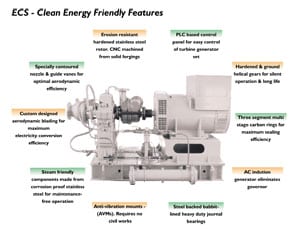 |
|
While the Pennant ECS can be put to multiple applications, multi-bagger benefits accrue with its ability to convert both saturated and superheated steam into clean electrical energy. Typically, the ECS is used in parallel with a Pressure Reducing Valve (PRV) or Pressure Reducing Desuperheater Station (PRDS) situated downstream of the |
Traditionally, the cogeneration of steam and electricity has only been practical for plants whose processes require the use of super-heated steam, making the recovery of waste energy from saturated steam impossible for many industrial sites ranging from distilleries, to pharmaceutical plants and pulp-and-paper mills.
This week at the Chem Show, Pennant International Corp. (Booth 1542) promises to change that with the introduction of its new Energy Conversion System (ECS) Series of saturated steam turbines. The turbines, which can also function with superheated steam, generate incidental electrical power while regulating and maintaining steam pressure like a conventional steam trap. They are intended to run in tandem with a parallel Pressure Reducing Valve (PRV) or Pressure Reducing Desuperheater Station (PRDS) and process-control software tasked with managing the pressure consistency of the exit stream. With steam typically produced at significantly higher temperatures and pressures than needed for its intended process application, the turbines promise greater resource efficiency, reduced energy consumption and associated environmental benefits.
For the past eight years, Pennant has installed specially commissioned versions of its saturated steam turbines for facilities in India, Dubai and elsewhere. The costs of system and installation vary based on steam throughput, but can be around $400,000 for a 77,000-lb/hr saturated steam flow and $250,000 for a 22,000-lb/hr flow. However, with power savings of $325,000 per year and $135,000 per year, respectively, Pennant estimates payback periods of less than two years (assuming in both cases an operation time of 8,000 hr/yr and an energy cost of 6.33 cents per kWh). The ECS Series is a slightly more modular concept based on the needs of the typical industries that would use them and function within a pressure range of 50–700 psi. They will be ready to ship within 5–6 months, according to Pennant representatives.